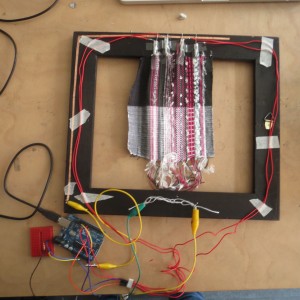For our textile embedded electronics week I decided to do a simple experiment with fiber optics. I really liked the quality and texture of the light it emits when the sides of the fiber are scratched.
More than a conceptual project, it was an experiment to try in one object a lot of possibilities of woven patterns and also of different fiber optics to see if they had different effects when lighted up.
For the interactive part of the project, I used a stretch sensor made of conductive yarn in a simple knot system. When stretched its conductive value increases, and Arduino reads that as values. Then according to these values, there were 4 stages were the LEDs connected to the fiber optics reacted.
There where a few things that I learned about this technique for any future projects: The woven patterns that I used to embed the fiber optics are too complex and in the end the fiber stays inside the fabric and it is difficult to see the light. In the future I would weave them in a way that they remain in the surface of the fabric. As well, the light emitted is to weak and it needs a lot of darkness to be seen. It is easier to see the light coming from the LEDs than the light that goes through the fiber. It is necessary to completely hide the light source so that the eye sees only the light emitted by the sides of the fiber optic cable.
